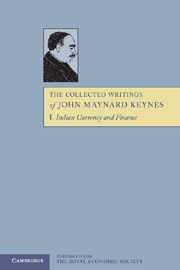Book contents
- Frontmatter
- Contents
- General introduction
- Editorial foreword
- Preface
- Dramatis personae
- 1 THE PRESENT POSITION OF THE RUPEE
- 2 THE GOLD-EXCHANGE STANDARD
- 3 PAPER CURRENCY
- 4 THE PRESENT POSITION OF GOLD IN INDIA AND PROPOSALS FOR A GOLD CURRENCY
- 5 COUNCIL BILLS AND REMITTANCE
- 6 THE SECRETARY OF STATE'S RESERVES AND THE CASH BALANCES
- 7 INDIAN BANKING
- 8 THE INDIAN RATE OF DISCOUNT
- Index
- Chart showing the rate of discount at the Presidency Bank of Bengal
1 - THE PRESENT POSITION OF THE RUPEE
Published online by Cambridge University Press: 05 November 2012
- Frontmatter
- Contents
- General introduction
- Editorial foreword
- Preface
- Dramatis personae
- 1 THE PRESENT POSITION OF THE RUPEE
- 2 THE GOLD-EXCHANGE STANDARD
- 3 PAPER CURRENCY
- 4 THE PRESENT POSITION OF GOLD IN INDIA AND PROPOSALS FOR A GOLD CURRENCY
- 5 COUNCIL BILLS AND REMITTANCE
- 6 THE SECRETARY OF STATE'S RESERVES AND THE CASH BALANCES
- 7 INDIAN BANKING
- 8 THE INDIAN RATE OF DISCOUNT
- Index
- Chart showing the rate of discount at the Presidency Bank of Bengal
Summary
On the broad historical facts relating to Indian currency, I do not intend to spend time. It is sufficiently well known that until 1893 the currency of India was on the basis of silver freely minted, the gold value of the rupee fluctuating with the gold value of silver bullion. By the depreciation in the gold value of silver, extending over a long period of years, trade was inconvenienced, and public finance, by reason of the large payments which the government must make in sterling, gravely disturbed; until in 1893, after the breakdown of negotiations for bimetallism, the Indian mints were closed to the free mintage of silver, and the value of the rupee divorced from the value of the metal contained in it. By withholding new issues of currency, the government had succeeded by 1899 in raising the gold value of the rupee to is 4d, at which figure it has remained without sensible variation ever since.
There can be no doubt that at first the government of India did not fully understand the nature of the new system; and that several minor mistakes were made at its inception. But few are now found who dispute on broad general grounds the wisdom of the change from a silver to a gold standard.
Time has muffled the outcries of the silver interests, and time has also dealt satisfactorily with what were originally the principal grounds of criticism, namely,
(a) that the new system was unstable,
(b) that a depreciating currency is advantageous to a country's foreign trade.
- Type
- Chapter
- Information
- The Collected Writings of John Maynard Keynes , pp. 1 - 10Publisher: Royal Economic SocietyPrint publication year: 1978



